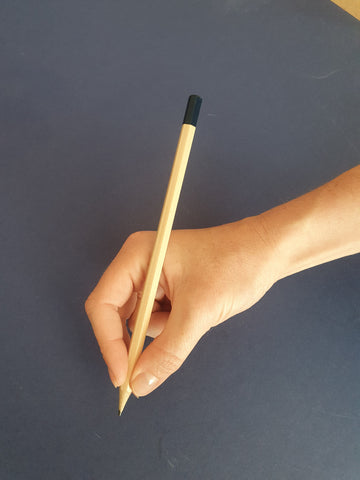
Crossing of the midline is the ability to rotate and efficiently reach across the midline of your body (an imaginary line down the centre of the body and limbs) to complete gross and fine motor activities.
Efficient crossing of the midline is important for visual perceptual learning (e.g., understanding how to form shapes, copy and form letters for handwriting), as well as the coordinated use of both sides of the body (e.g. 'helper & doing' hand while using scissors).
Mature midline crossing patterns should be demonstrated by ages 4 – 6 years. During this period of time, children also tend to develop a more functional and dynamic pencil grasp with a dominant hand. If a child has difficulties with midline crossing; this can delay the emergence of a dominant hand for fine motor tasks which in turn can also impact on their performance in fine motor tasks such as colouring, buttoning, dressing, writing and using scissors as he/she may swap between hands constantly.
It's very important to note that, a dominant hand should not be forced on a child & if you have persistent concerns in relation to this; you should consult a Paediatric Occupational Therapist or arrange an online consultation.
How do I know if my child is having problems with midline crossing ?
There might be a few things you observe:

It's very important to note that children at a certain developmental stage will swap hands (more below in the pencil grasp section) as they are only learning about their body & bilateral coordination (the ability to carry out co-ordinated movements of the right and left sides of the body and to cross the mid-line of the body)
What activities develop a child's ability to cross their midline?
Here are my TOP 5 ACTIVITIES to try at home:
1. Yoga and pilates poses that encourage trunk rotation and stretching across the body.
2. Place finger puppets on one hand (held away from their body) so they can be removed with the opposite hand by reaching over. I love using finger puppets with kids as they are a great way to develop fine motor skills & pretend play. I enjoy them so much, I included some in my Preschool Farmyard Pack.

3. Make an obstacle course that includes walking sideways along a line/rope/balance beam - crossing legs over each other.
4. Passing beanbags from one hand to the other across the body - try to do this blindfolded and have them far enough that their body is turning.
5. Reach across the body & hit a suspended ball with a bat e.g. you could even put a tennis ball in the toe of a stocking and hang it from the clothesline.

So let's discuss pencil grasp development so you know what age swapping between hands is expected. This is just a guide as the developmental path for every child is different & if you are concerned; please consult an OT or get in contact to arrange an online session.
Fisted Grasp: When a child initially starts using a crayon, chalk or pencil, he/she will likely hold it in a closed fist or palmar supinate grasp. This is a fisted grasp position on the pencil with the thumb wrapped at the top. This can start anywhere between 11-18months. Your child may swap between hands with movements coming from the shoulder. From around 14months, they may imitate to & fro scribbles. This is considered a primitive grasp.

Fisted Grasp
Digital Pronate Grasp: The fingers are now pointed down towards the bottom of the pencil and all the fingers are in use. A child may develop this grasp typically around 2-3 years old & they will continue to use whole arm movements to scribble.

Digital Pronate Grasp
Static Tripod Grasp or Static Quadrupod Grasp: When a child is between 3-4 years old; they may switch to holding the pencil with a static tripod grasp with index,middle finger and thumb on the pencil or a quadrupod grasp with the ring finger on the shaft aswell for increased stability. Children will hold the pencil with the whole pads of their fingers with the fingers in a static position. Both of these grips are considered functional grasps as the webspace is open (space between index & thumb).

Static Tripod Grasp
Dynamic Tripod grasp: Your child's grasp will mature between the ages 4-6 as they attend preschool & then make the transition to primary school. Their fingers can move more independently in a dynamic grasp and this allows for more precise colouring, drawing & writing. In this position, the ring & little finger curl into the palm and the web-space (space between thumb & index) becomes more circular. However, children can struggle to adopt this grasp for many reasons including lower muscle tone, hypermobility, motor planning difficulties etc.
Lots of us have very unusual but functional pencil grasps - meaning that the grasp doesn't cause fatigue, the handwriting is legible and it is overall efficient. There are lots of grips that are considered functional however if there are legibility issues, joint pain or strain and fatigue - then it is worth consulting an OT for support around this.

Dynamic Tripod Grasp
Hope you have found this blog post helpful; make sure to contact me if you have any specific questions or suggestions for future posts. If you work in a school, why not look at out School CPD Plans which can benefit both staff and pupils
Jess